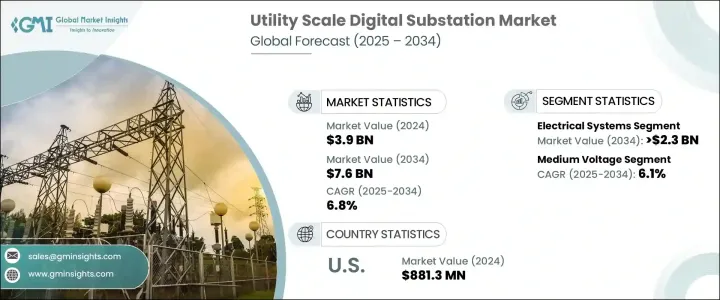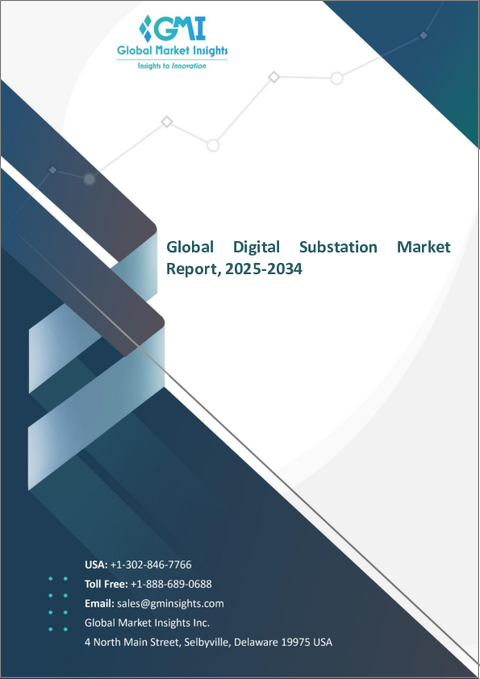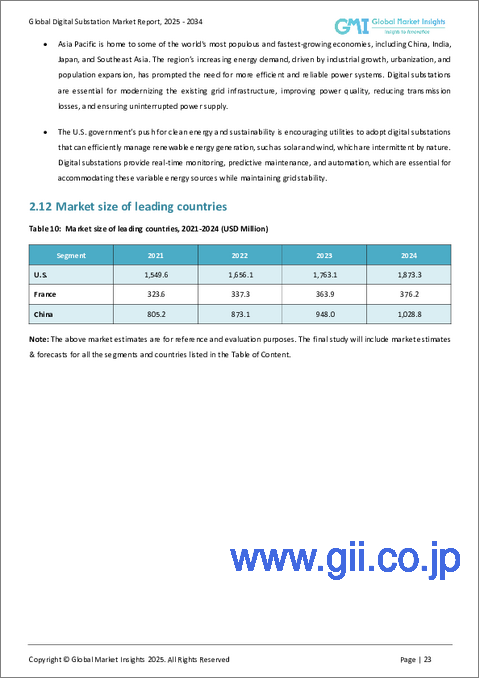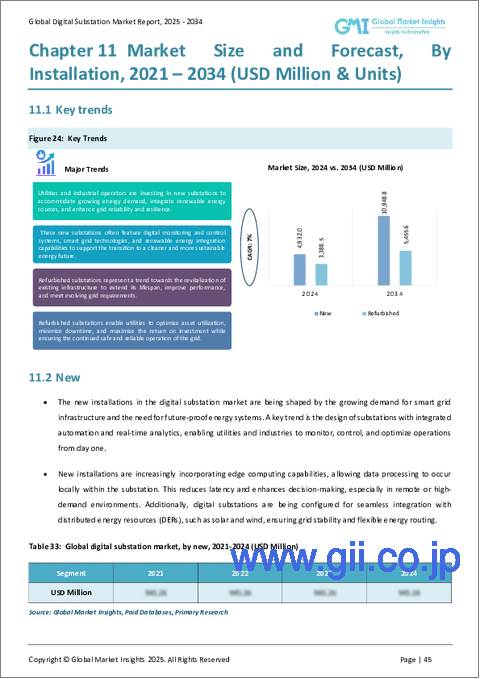|
|
市場調査レポート
商品コード
1750569
ユーティリティスケールデジタル変電所市場の機会、成長促進要因、産業動向分析、2025年~2034年の予測Utility Scale Digital Substation Market Opportunity, Growth Drivers, Industry Trend Analysis, and Forecast 2025 - 2034 |
||||||
カスタマイズ可能
|
|||||||
| ユーティリティスケールデジタル変電所市場の機会、成長促進要因、産業動向分析、2025年~2034年の予測 |
|
出版日: 2025年05月13日
発行: Global Market Insights Inc.
ページ情報: 英文 120 Pages
納期: 2~3営業日
|
- 全表示
- 概要
- 目次
世界のユーティリティスケールデジタル変電所市場は、2024年には39億米ドルと評価され、特に再生可能エネルギー源へのシフトに伴い、より効率的で信頼性の高い配電システムに対する需要の高まりに後押しされ、CAGR 6.8%で成長し、2034年には76億米ドルに達すると推定されています。
老朽化したインフラは、スマートメーター、自動化システム、高度な監視機能を含むデジタル変電所を組み込むためにアップグレードされつつあります。この近代化により、電力会社はリアルタイムのデータを監視し、配電をよりよく管理する能力が強化されます。高度計測インフラ(AMI)と監視制御・データ収集(SCADA)システムを導入することで、電力会社はエネルギー損失を削減できるだけでなく、送電網の応答性と信頼性も高めることができます。これらのデジタルソリューションは、リアルタイムの監視、負荷分散、迅速な故障検出を可能にし、これらは現代の電力ネットワークの効率的な運用に不可欠です。

エネルギー消費パターンが進化し、電力網が複雑化し続ける中、デジタル技術はもはやオプションではなく、必要不可欠なものとなっています。電力会社は、多様な再生可能エネルギー源を統合しながら、信頼性を確保し、停電を最小限に抑え、変動する需要と供給のバランスをとるよう、ますます強く求められています。このようなダイナミックな状況では、リアルタイムのデータ可視化、迅速な意思決定、インテリジェントな自動化が求められます。デジタル変電所は、従来の送電網インフラをより柔軟で適応性の高いネットワークに変えるのに役立ちます。これらのシステムは、予知保全、故障検出、自動応答メカニズムを可能にし、ダウンタイムと運用の非効率性を低減します。また、オペレーターが遠隔地から資産を監視し、分散化が進む電力ネットワーク全体のエネルギーフローを最適化することもできます。
| 市場範囲 | |
|---|---|
| 開始年 | 2024 |
| 予測年 | 2025-2034 |
| 開始金額 | 39億米ドル |
| 予測金額 | 76億米ドル |
| CAGR | 6.8% |
ユーティリティスケールデジタル変電所市場の電気システム部門は、2034年までに23億米ドルに達します。これは、高圧送電線のアップグレードへの一貫した投資と、再生可能エネルギーを国家送電網に統合する取り組みの増加によるものです。太陽光発電、風力発電、水力発電の増加に伴い、変動を管理し、長距離送電を円滑に行うための堅牢な電気システムが必要となります。老朽化した送電網を近代化する必要性が高まっているため、電力会社はインテリジェント・オートメーションとフォールト・トレラント技術を備えた次世代変電設備への投資を進めています。
一方、中電圧分野は力強い勢いを維持し、2034年までCAGR 6.1%で成長すると予想されます。この成長は、分散型エネルギー・システムの台頭と関連しており、局所的な発電とスマート・マイクログリッドが人気を集めています。中電圧ネットワークは、特に工業団地、住宅開発、商業ゾーンにおいて、変電所からエンドユーザーへの配電のバックボーンとなっています。政府と民間のエネルギー・プロバイダーは、負荷予測、ピーク需要制御、資産最適化をサポートするデジタル高圧ソリューションへの資金投入を増やしており、これらはすべて、レジリエントでフレキシブルなエネルギー・グリッドにとって重要な機能です。
米国のユーティリティスケールデジタル変電所2024年の市場規模は8億8,130万米ドル。同国は、進化するエネルギー情勢に対応するため、電力インフラの近代化に大きく前進しています。公益事業者は、レガシーシステムを積極的に廃止し、システム診断の改善、予知保全機能、合理化された運用を提供する完全自動化デジタル変電所を選好しています。この移行は、送電網の信頼性を強化し、スマートエネルギー技術の採用を加速することを目的とした連邦政府のイニシアチブと資金提供プログラムによって大きく支えられています。
同市場ポジションを強化するため、ユーティリティスケールデジタル変電所市場の企業はさまざまな戦略を採用しています。革新的な技術の開発と改良に注力し、エネルギー配給の進化するニーズに対応した製品ラインナップの充実を図り、電力会社やエネルギープロバイダーとパートナーシップを結んで市場拡大を図っています。デジタル・インフラやオートメーションへの戦略的投資も、こうした企業の競争力維持に役立っています。さらに、スマートグリッドソリューションに対する需要の高まりに対応しながら、世界中の大規模インフラプロジェクトをサポートできるよう、世界展開にも注力しています。こうした戦略は、企業が市場での地位を向上させ、拡大するこの分野での成長に向けて自らを位置づけるのに役立っています。
目次
第1章 調査手法と範囲
第2章 エグゼクティブサマリー
第3章 業界考察
- エコシステム分析
- 規制情勢
- 業界への影響要因
- 促進要因
- 業界の潜在的リスク&課題
- 成長可能性分析
- ポーター分析
- PESTEL分析
第4章 競合情勢
- 戦略的ダッシュボード
- イノベーションと持続可能性の情勢
第5章 市場規模・予測:コンポーネント別、2021年~2034年
- 主要動向
- 変電所自動化システム
- 通信ネットワーク
- 電気システム
- 監視制御システム
- その他
第6章 市場規模・予測:アーキテクチャ別、2021年~2034年
- 主要動向
- プロセス
- ベイ
- ステーション
第7章 市場規模・予測:電圧別、2021年~2034年
- 主要動向
- 低電圧
- 中電圧
- 高電圧
第8章 市場規模・予測:設置別、2021年~2034年
- 主要動向
- 新規
- リファービッシュ
第9章 市場規模・予測:地域別、2021-2034
- 主要動向
- 北米
- 米国
- カナダ
- メキシコ
- 欧州
- 英国
- フランス
- ドイツ
- イタリア
- ロシア
- スペイン
- アジア太平洋地域
- 中国
- オーストラリア
- インド
- 日本
- 韓国
- 中東・アフリカ
- サウジアラビア
- アラブ首長国連邦
- トルコ
- 南アフリカ
- エジプト
- ラテンアメリカ
- ブラジル
- アルゼンチン
第10章 企業プロファイル
- ABB
- Belden
- Cisco Systems
- Eaton
- Efacec
- General Electric
- Grid to Great
- Hitachi Energy
- Larsen &Toubro Limited
- Netcontrol Group
- Schneider Electric
- Siemens
- SIFANG
- Tesco Automation
- Texas Instruments Incorporated
- Toshiba
The Global Utility Scale Digital Substation Market was valued at USD 3.9 billion in 2024 and is estimated to grow at a CAGR of 6.8% to reach USD 7.6 billion by 2034, fueled by the rising demand for more efficient and reliable power distribution systems, especially with the shift toward renewable energy sources. Aging infrastructure is being upgraded to incorporate digital substations, which include smart meters, automated systems, and advanced monitoring capabilities. This modernization enhances the ability of utilities to monitor real-time data and better manage electricity distribution. By deploying Advanced Metering Infrastructure (AMI) and Supervisory Control and Data Acquisition (SCADA) systems, utilities can not only reduce energy loss but also boost grid responsiveness and reliability. These digital solutions enable real-time monitoring, load balancing, and faster fault detection, which are vital for the efficient operation of modern power networks.

As energy consumption patterns evolve and the complexity of power grids continues to grow, digital technologies are no longer optional-they're essential. Utilities are under increasing pressure to ensure reliability, minimize outages, and balance supply with fluctuating demand, all while integrating a diverse mix of renewable energy sources. This dynamic landscape demands real-time data visibility, rapid decision-making, and intelligent automation, which digital solutions are uniquely equipped to deliver. Digital substations help transform conventional grid infrastructure into more flexible and adaptive networks. These systems enable predictive maintenance, fault detection, and automated response mechanisms that reduce downtime and operational inefficiencies. They also allow operators to remotely monitor assets and optimize energy flows across increasingly decentralized power networks.
| Market Scope | |
|---|---|
| Start Year | 2024 |
| Forecast Year | 2025-2034 |
| Start Value | $3.9 Billion |
| Forecast Value | $7.6 Billion |
| CAGR | 6.8% |
The electrical systems component of the utility-scale digital substations market will reach USD 2.3 billion by 2034. This is due to consistent investments in upgrading high-voltage transmission lines and increasing efforts to integrate renewable energy into national grids. As more solar, wind, and hydro sources come online, robust electrical systems are necessary to manage fluctuations and ensure smooth transmission over long distances. The growing need to modernize aging transmission networks is pushing utilities to invest in next-gen substation components equipped with intelligent automation and fault-tolerant technology.
Meanwhile, the medium voltage segment is expected to maintain strong momentum, growing at a CAGR of 6.1% through 2034. This growth is tied to the rise of decentralized energy systems, where localized power generation and smart microgrids are gaining traction. Medium voltage networks are the backbone for distributing electricity from substations to end users, particularly in industrial parks, residential developments, and commercial zones. Governments and private energy providers are increasingly channeling funds into digital medium voltage solutions that support load forecasting, peak demand control, and asset optimization-all critical functions for a resilient and flexible energy grid.
United States Utility Scale Digital Substation Market was valued at USD 881.3 million in 2024. The country is making major strides in modernizing its power infrastructure to meet the evolving energy landscape. Utilities are actively phasing out legacy systems in favor of fully automated digital substations, which offer improved system diagnostics, predictive maintenance capabilities, and streamlined operations. This transition is heavily supported by federal initiatives and funding programs aimed at enhancing grid reliability and accelerating the adoption of smart energy technologies.
Key players in the market include ABB, Belden, Cisco Systems, Eaton, Efacec, General Electric, Hitachi Energy, Larsen & Toubro Limited, Netcontrol Group, Schneider Electric, Siemens, SIFANG, Tesco Automation, Texas Instruments Incorporated, and Toshiba. To strengthen their market position, companies in the utility-scale digital substation market are employing a range of strategies. They focus on developing and refining innovative technologies, enhancing their product offerings to meet the evolving needs of energy distribution, and forming partnerships with utilities and energy providers to expand their market reach. Strategic investments in digital infrastructure and automation are also helping these companies stay competitive. Furthermore, they focus on global expansion, ensuring they can support large-scale infrastructure projects worldwide while meeting the increasing demand for smart grid solutions. These strategies help companies improve their market standing and position themselves for growth in this expanding sector.
Table of Contents
Chapter 1 Methodology & Scope
- 1.1 Market definitions
- 1.2 Base estimates & calculations
- 1.3 Forecast calculation
- 1.4 Data sources
- 1.4.1 Primary
- 1.4.2 Secondary
- 1.4.2.1 Paid
- 1.4.2.2 Public
Chapter 2 Executive Summary
- 2.1 Industry synopsis, 2021 - 2034
Chapter 3 Industry Insights
- 3.1 Industry ecosystem analysis
- 3.2 Regulatory landscape
- 3.3 Industry impact forces
- 3.3.1 Growth drivers
- 3.3.2 Industry pitfalls & challenges
- 3.4 Growth potential analysis
- 3.5 Porter's analysis
- 3.5.1 Bargaining power of suppliers
- 3.5.2 Bargaining power of buyers
- 3.5.3 Threat of new entrants
- 3.5.4 Threat of substitutes
- 3.6 PESTEL analysis
Chapter 4 Competitive landscape, 2024
- 4.1 Strategic dashboard
- 4.2 Innovation & sustainability landscape
Chapter 5 Market Size and Forecast, By Component, 2021 - 2034 (USD Million)
- 5.1 Key trends
- 5.2 Substation automation system
- 5.3 Communication network
- 5.4 Electrical system
- 5.5 Monitoring & control system
- 5.6 Others
Chapter 6 Market Size and Forecast, By Architecture, 2021 - 2034 (USD Million)
- 6.1 Key trends
- 6.2 Process
- 6.3 Bay
- 6.4 Station
Chapter 7 Market Size and Forecast, By Voltage, 2021 - 2034 (USD Million)
- 7.1 Key trends
- 7.2 Low
- 7.3 Medium
- 7.4 High
Chapter 8 Market Size and Forecast, By Installation, 2021 - 2034 (USD Million)
- 8.1 Key trends
- 8.2 New
- 8.3 Refurbished
Chapter 9 Market Size and Forecast, By Region, 2021 - 2034 (USD Million)
- 9.1 Key trends
- 9.2 North America
- 9.2.1 U.S.
- 9.2.2 Canada
- 9.2.3 Mexico
- 9.3 Europe
- 9.3.1 UK
- 9.3.2 France
- 9.3.3 Germany
- 9.3.4 Italy
- 9.3.5 Russia
- 9.3.6 Spain
- 9.4 Asia Pacific
- 9.4.1 China
- 9.4.2 Australia
- 9.4.3 India
- 9.4.4 Japan
- 9.4.5 South Korea
- 9.5 Middle East & Africa
- 9.5.1 Saudi Arabia
- 9.5.2 UAE
- 9.5.3 Turkey
- 9.5.4 South Africa
- 9.5.5 Egypt
- 9.6 Latin America
- 9.6.1 Brazil
- 9.6.2 Argentina
Chapter 10 Company Profiles
- 10.1 ABB
- 10.2 Belden
- 10.3 Cisco Systems
- 10.4 Eaton
- 10.5 Efacec
- 10.6 General Electric
- 10.7 Grid to Great
- 10.8 Hitachi Energy
- 10.9 Larsen & Toubro Limited
- 10.10 Netcontrol Group
- 10.11 Schneider Electric
- 10.12 Siemens
- 10.13 SIFANG
- 10.14 Tesco Automation
- 10.15 Texas Instruments Incorporated
- 10.16 Toshiba






